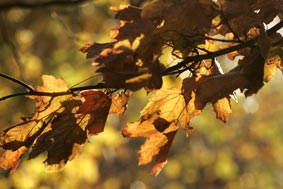Nature: Autumn rainbow

Éanna Ní Lamhna on the scientific reasons for the change in colour in autumn leaves
O wild West Wind, thou breath of Autumn's being / Thou, from whose unseen presence the leaves dead / Are driven, like ghosts from an enchanter fleeing / Yellow, and black, and pale, and hectic red,
Pestilence-stricken multitudes:
Shelley was well able to describe the effects of the wild west wind on the leaves at this time of year, but he is not forthcoming on why there is this great variety of colours – everything except green.
At these latitudes, our natural vegetation is deciduous woodland. Trees native to this part of the world have broad, flat leaves that are very good at catching the light from the sun and carrying out photosynthesis. They are each angled in an optimal way so they overlap as little as possible. Our trees burst into growth in late spring and continue at full speed all summer long.
But our frosts and long dark nights are not so good for our big, broad-leafed trees which would surely freeze at the extremities and suffer damage if these leaves were still operational. So the survival strategy is to lose them and go into hibernation as it were. Retrench, keep the sap down, stop growing.
The tree withdraws all the green chlorophyll molecules from its leaves and then lays down a layer of cork between the twig and the leaf stalk. So when the leaf falls off, there is not a gaping wound through which disease might enter, but a nice scab made of cork covering the abscission. When the green colour is withdrawn from the leaf, the other pigments, which were there all the time masked by the green, begin to be displayed in all their glory.
Carotenoids are yellow, orange and red pigments that occur in leaf tissues. They consist of carotenes, which have the yellow and orange colours and xantophylls, which are the red ones. Maple, mountain ash and cherry trees have a lot of the latter and are putting on a terrific show at the moment.
Variegated leaves – those yellow and green ones that gardeners of holly and ivy, golden Leyland cypress and yellow Grisellinia hedges are so fond of – are scéal eile entirely. Their yellow colour is caused by a virus that has been deliberately inserted into the leaves to gobble up the chlorophyll. If it does a really good job of it, the leaves are entirely yellow.
If it is less vigorous, the yellow and green variegation occurs. The whole thing is highly unnatural and can only exist in cosseted garden situations, as such half-baked leaves cannot compete with normal ones with their full complement of chlorophyll and the plant will revert back to full green if it gets half a chance.
